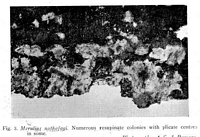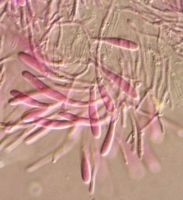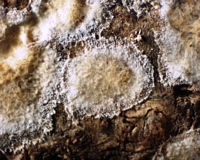|
 Phlebia rufa Phlebia rufa
SynonymsMerulius nothofagi
Merulius pallens
Merulius rufus
BiostatusPresent in region - Indigenous. Non endemic
Images (click to enlarge)
Caption: Fig. 3. Merulius nothofagi. Numerous resupinate colonies with plicate centres in some. x1 | 
Caption: Phlebia rufa - cystidia from margin, BCP 2103
Owner: B.C. Paulus | 
Caption: Phlebia rufa, BCP 2103
Owner: B.C. Paulus |
Article: Cunningham, G.H. (1950). New Zealand Polyporaceae. 12. The genus Merulius. New Zealand Department of Scientific and Industrial Research, Plant Diseases Division, Bulletin 83: 12 p.
Description: Hymenophore annual. resupinate, linear or irregularly orbicular when of several solitary or
fused colonies 0.5-10 cm. long, 0.5-3 cm. broad, 0.4-1 mm. thick; hymenial surface cream to
pallid ochre, poroid-reticulate, reticulations sometimes reduced to warts or blunt spines,
usually 1-3 per mm., to 0.5 mm. deep; margin byssoid, slightly lifting, white or cream,
crenate, sometimes translucent, with a sterile border 1-2 mm. wide. Context white,
coriaceous, 200-400 µ thick, lowerr part of densely woven hyphae, intermediate layer lacunar
beneath the hymenium enclosing numerous large crystals; generative hyphae to 8 µ diameter,
wall 2 µ thick, branched, septate, contents staining, clamp connections abundant. Hymenial
layer separable, 50-100 µ deep. Basidia long-clavate, 16-24 x 4-5 µ, persistent. Gloeocystidia
to 50 x 8 µ when embedded in folds of the hymenium, 80-100 x 12-16 µ in the context,
contents granular, hyaline or pallid yellow, sometimes crystal-coated apically. Spores
elliptical, elliptic-obovate, or allantoid, 4-5 x 1.5-2 µ, smooth, hyaline.
Habitat: HABITAT: Solitary or caespitose on bark of fallen branches.
Distribution: DISTRIBUTION: New Zealand.
Notes: In general appearance this species resembles M. tremellosus but differs in heing resupinate,
not gelatinous, and in certain micro-features. Specific features are the pallid colour of the
hymenium, stout generative hyphae with abundant clamp connections, small spores and
presence of gloeocystidia.
|